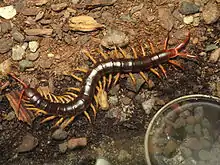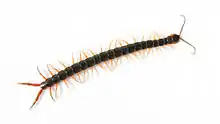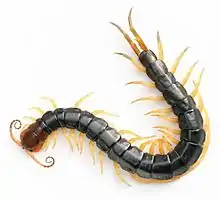Scolopendra subspinipes
Scolopendra subspinipes is a species of very large centipede found throughout eastern Asia. One of the most widespread and common species in the genus Scolopendra, this species is also found on virtually all land areas around and within the Indian Ocean, all of tropical and subtropical Asia from Russia to the islands of Malaysia and Indonesia, Australia, South and Central America, the Caribbean islands, and possibly parts of the southern United States. However, how much of this range is natural and how much due to human introduction is unclear.[1][2] With a wide geographic range and numerous color variations, the species is known by a great many common names including Chinese red-headed centipede, jungle centipede, orange-legged centipede, red-headed centipede and Vietnamese centipede.
| Scolopendra subspinipes | |
|---|---|
 | |
| Scientific classification | |
| Kingdom: | Animalia |
| Phylum: | Arthropoda |
| Class: | Chilopoda |
| Order: | Scolopendromorpha |
| Family: | Scolopendridae |
| Genus: | Scolopendra |
| Species: | S. subspinipes |
| Binomial name | |
| Scolopendra subspinipes | |
| Synonyms | |
|
Rhombocephalus smaragdinus | |
It is among the largest centipedes with a maximum length of 20 cm.[3] This centipede is an active, aggressive predator that preys on any animal it can overpower.[4]
Description

This is a large species which can grow up to 20 cm in length.[3] It has colour variations. Its body is usually red or reddish brown with yellow or yellow-orange legs. In common with other members of genus Scolopendra, it has 22 body segments with each segment having one pair of legs. A pair of modified legs known as forcipules can be found on its head, which is covered by a flat shield and bears a pair of antennae. The forcipules are the major tools used by the centipede to kill its prey or for defense, as they have sharp claws that connect to venom glands. Centipedes breathe through spiracles (the openings located along the sides of their bodies). These openings are either round-shaped or S-shaped. They have simple eyes with poor vision, so they rely much on touch and their chemoreceptors.[5]
Habitats
The species can be found in tropical and subtropical regions throughout the Old World. It is also one of only three species of centipedes in Hawaii.[6]
Diet and behavior
This is an aggressive and nervous arthropod which is ready to strike if interfered with and is sensitive to vibrations nearby.[3][4] It preys primarily on arachnids, including spiders, scorpions, and vinegaroons. However, if it is large enough to overpower small vertebrates like mice or small reptiles, it will readily attempt to consume them as well. It tends to try to eat almost every living animal it encounters that is not longer than itself.[4] It seizes prey with its anterior legs, then curves its head quickly behind to implant its venomous jaws deeply and firmly into the prey. The prey is held by the centipede's other legs until it dies from the fast-acting venom. During a fight, the centipede will use its entire body coiling the prey or enemy with its legs firmly attaching to the body of the opponent. Then, it will quickly penetrate its forcipules into the victim for venom injection.[6]
Reproduction
The male produces capsules containing mature sperm cells, spermatophores, which are deposited in a reservoir called the spermathecae of the female during mating. The female then fertilizes her immature eggs, oocytes, and deposits them in a dark, protected area. The female lays 50 to 80 eggs which she vigilantly protects until they hatch and the baby centipede molt once. If danger is detected she will wrap around her babies to keep them safe. The young centipedes molt once each year, and take three to four years to attain full adult size. Adults molt once every year. They may live for 10 years or more.[6]
Venom
Scolopendra subspinipes has been reported as the apparent cause of a human death. The fatal case was in Philippines in which the centipede bit a seven-year-old girl on her head. She died 29 hours later.[4]
Human uses
S. subspinipes is a popular pet among arthropod hobbyists.[4] The centipede was a traditional food source for Aboriginal Australians [7]
Subspecies
The number of subspecies of S. subspinipes is unclear and varies between authors. Taxonomic characters have incorporated plastic traits such as color and sulcus structure and the number and position of spines, producing indistinguishable and intergrading subspecies.[2] A 2012 review found that one former subspecies, S. subspinipes cingulatoides is in fact a distinct species, and that S. subspinipes has no valid subspecies.[2]
References
- Australian Faunal Directory. "Species Scolopendra subspinipes Leach, 1815". Department of the Environment and Water Resources.
- Kronmüller, Christian (2012). "Review of the subspecies of Scolopendra subspinipes Leach, 1815 with the new description of the South Chinese member of the genus Scolopendra Linnaeus, 1758 named Scolopendra hainanum spec. nov.: (Myriapoda, Chilopoda, Scolopendridae)". Spixiana. 35: 19–27.
- "Vietnamese centipede".
- "Vietnamese Centipede (Scolopendra subspinipes)".
- "Centipedes".
- Dugon, Michel M.; Arthur, Wallace (2012-06-01). "Prey orientation and the role of venom availability in the predatory behaviour of the centipede Scolopendra subspinipes mutilans (Arthropoda: Chilopoda)". Journal of Insect Physiology. 58 (6): 874–880. doi:10.1016/j.jinsphys.2012.03.014. ISSN 0022-1910.
- Johnston, T. Harvey (1943). "Aboriginal names and utilization of the fauna in the Eyrean region". Transactions of the Royal Society of South Australia. 67 (2): 243–311.
| Wikimedia Commons has media related to Scolopendra subspinipes. |

